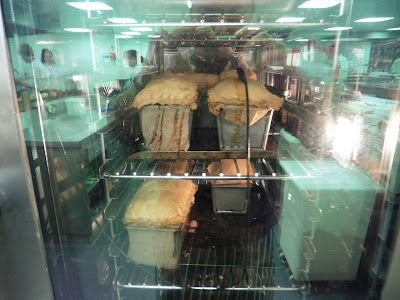It uses hot water crust pastry - and it worked really well. It had the sort of crunch you get from a good pork pie, but was still moist and not too biscuity. We cooked the pies in a steam oven, but you can get near this by using a normal oven and putting a tray of water on the bottom rack.
Hot water crust pastry
(makes one large pie)
500g plain flour
200ml water
120g butter
70g lard
1 tsp salt
Sieve the flour and salt into a bowl. Heat the water in a pan, and when boiling, add the butter and lard. Stir until the fat has dissolved, then pour into the flour. Let it cool slightly, then knead it for a few minutes to form a ball with the consistency of Play-doh. Cover the dough to stop it drying out while you get on with the rest of the ingredients.
Take a medium-size loaf tin and brush the inside with oil. Then cut a piece of greaseproof paper the width of the tin base, but long enough so it hangs over the ends. Line the tin making sure a few inches of paper are sticking out on either end - you'll use these as 'handles' to remove the pie from the tin. Brush the paper with oil.
Then this is where the Play-doh consistency comes in. Take pieces of dough, and flatten into patty shapes and form the pie crust, making sure you push it into the corners. Make sure the crust is about an inch taller than the loaf tin. You want the crust to be about the width of a pencil.
Next fill with the meat mixture. You can use whatever you want for this - thinly-sliced pork loin with finely chopped bacon and onion works very well. For ours, we used freshly-minced venison and wild boar. We put sage, pepper and salt in the pork, and nutmeg, salt, pepper and mustard powder in the venison.
We then fried off a little of each to check the seasoning. The tutor said the venison was too "tight", so we added eggs, breadcrumbs and red wine to loosen it up.
We then built up the pie, starting with a 100g layer of pork, then a 100g layer of venison, and so on, so the pie had a two-tone effect. When the pie was filled an inch past the top, we rolled out the rest of the dough and cut out a piece for the lid. We moulded the overhanging dough into the lid and then trimmed and fluted the edges.
We cut a hole in the top to allow the steam to escape, and baked the pies at 160C in a steam oven for about an hour. You know it's ready when the middle of the pie is 75C. Take the pie out of the oven and carefully remove from the tin using the overhanging paper. Then let them cool on a wire tray.
Meanwhile, we had made chicken stock from trimmings from a dish the other Level 2 NVQ Diploma in Catering class had made. When this was ready we boiled down a couple of litres and added enough gelatine so it set easily in the fridge. We poured this through the pie holes and then let them sit in the fridge for the jelly to set.








No comments:
Post a Comment